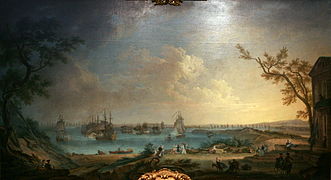The Expeditionary Corps Embarks for Minorca at the Port of Marseille Under the Command of Marshal de Richelieu
- View a machine-translated version of the French article.
- Machine translation, like DeepL or Google Translate, is a useful starting point for translations, but translators must revise errors as necessary and confirm that the translation is accurate, rather than simply copy-pasting machine-translated text into the English Wikipedia.
- Do not translate text that appears unreliable or low-quality. If possible, verify the text with references provided in the foreign-language article.
- You must provide copyright attribution in the edit summary accompanying your translation by providing an interlanguage link to the source of your translation. A model attribution edit summary is
Content in this edit is translated from the existing French Wikipedia article at [[:fr:Embarquement du corps expéditionnaire de Minorque]]; see its history for attribution. - You may also add the template
{{Translated|fr|Embarquement du corps expéditionnaire de Minorque}}to the talk page. - For more guidance, see Wikipedia:Translation.

The Expeditionary Corps Embarks for Minorca at the Port of Marseille Under the Command of Marshal de Richelieu is a major oil on canvas painting by Jean-Joseph Kapeller, signed and dated 26 March 1756. It was acquired by the French state in 1941 and assigned to musée Cantini in Marseille.[1]
It was first exhibited on 29 August 1756 in the 'salle du Modèle' at the Académie de peinture de Marseille with the title The Port of Marseille and the Embarkation of War Munitions and Shot for the Expedition to the Island of Minorca, by Order and in the Presence of Monsieur the Marshal de Richelieu.[2]
Description
Analysis
Port, military and commercial square opened upon the world
Methodological precautions
Historical Context
The Duke of Richelieu and Fronsac, Cardinal Richelieu's great-grandnephew, left Paris on 18 March 1756, hoping to find everything underway in Marseille. He was badly disappointed - the troops had still not been concentrated in Marseille, whilst there were no supplies and no transport ships in a fit state to go to sea. On 22 March he gave orders at Marseille and the following day headed for Toulon, leaving the chevalier de Redmond and Monsieurs de Luppé and de Retz to continue preparations at Marseille.[3]
The painting shows de Richelieu setting out for the Battle of Minorca, a land and sea battle between France and Britain in May–June 1756 early in the Seven Years' War over control of Minorca and the western Mediterranean Sea. The naval element on 20 May between a force under de Richelieu's cousin La Galissonière and one led by John Byng allowed France to hold the island until the end of the war.[4]
| Related works |
|---|
|
Notes
- ^ Shows the Old Port at Marseille seen from the Canebière. In the Paris Salon catalogue of 1755 it stated that it showed "how it is in this port which has the greatest commerce with the Levant, the artist enriched this painting with figures from different nations from the different nations of the 'Échelles du Levant', Barbary, Africa and other areas. It gathers what characterises a merchant port with very wide trading networks."
References
- ^ (in French) "Catalogue entry on Joconde".
- ^ (in French) Charles-Philippe de Chennevières-Pointel, Recherche sur la vie et les ouvrages de quelques Peintres Provinciaux de l'Ancienne France, volume II, Paris, Librairie Dumoulin, 1850 (republished Genève, Minkoff reprint, 1973) (1st edition 1847), p. 41
- ^ (in French) Le comte Pajol, Les Guerres sous Louis XV, volume VI, Paris, Firmin-Didot, 1888 (1re éd. 1881), chap. I (« Prise de Mahon (1756) »), p. 4 and 5.
- ^ (in French) Georges Lacour-Gayet, La Marine militaire de la France sous le règne de Louis XV, Honoré Champion éditeur, 1902

![Inside the Port of Marseille, 1754, by Claude Joseph Vernet (Musée de la Marine)[a]](http://upload.wikimedia.org/wikipedia/commons/thumb/0/0b/Vernet-marseille-1754.jpg/248px-Vernet-marseille-1754.jpg)










